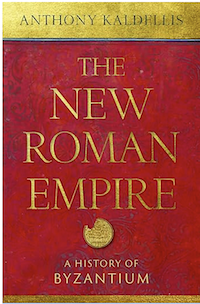 I am currently reading The New Roman Empire by Anthony Kaldellis. A history of the Eastern Empire, it runs to 1,000 pages, which isn’t long enough, given the length of time and the density of incident recorded. Among the many subjects covered are the theological and political controversies of the fourth and fifth centuries.
I am currently reading The New Roman Empire by Anthony Kaldellis. A history of the Eastern Empire, it runs to 1,000 pages, which isn’t long enough, given the length of time and the density of incident recorded. Among the many subjects covered are the theological and political controversies of the fourth and fifth centuries.
The major theological debate in the fourth century was over the relationship between Jesus Christ and God the Father. This subject was of obvious importance to the development of Christianity, and it was more or less resolved by the Council of Nicaea in 325. The Nicene Creed is now accepted, I believe, by nearly all Christian denominations.
The great theological debate of the fifth century, in contrast, was over a much lesser issue: the precise nature of Jesus’s divinity and human form. The two sides are generally referred to as advocating for either One Nature or Two Natures. At least one prominent cleric was beaten to death by a mob that disagreed with his position on that question.
What does this have to do with 21st century politics? I found this discussion striking:
Narratives began to coalesce around theological slogans, with grievances, villains, heroes, and even martyrs; in other words, beyond the theological issues at stake these positions were becoming identities.
***
The Christological division over Natures differed from that of the fourth century about the Father and Son in one more way: in the fourth century, partisans disagreed with the theological positions of their opponents, whereas in the fifth and sixth centuries they disagreed with largely imaginary positions that they only attributed to their opponents, often while the latter were clearly proclaiming that they did not hold those positions. … The need to create identities by inventing caricatures and then demonizing those who allegedly believed them proved to be greater than the desire for consensus.
One could argue that not much has changed in the intervening 1,600 years.
UPDATE: My wife reminds me that she bought me this book for Christmas after reading a review in the Claremont Review of Books by Professor James Hankins of Harvard:
The most important book about the history of Western civilization published this year—and for many years—is Anthony Kaldellis’ magnum opus, The New Roman Empire: A History of Byzantium. Kaldellis’ first task was to convince his readers that the Byzantines were part of Western history at all, since for many years now courses and books on Western civ have slighted the eastern Roman empire, consciously or unconsciously following the verdict of Enlightenment historian Edward Gibbon. Gibbon took the fate of the Latin-speaking parts of the classical empire as the main focus of his famous work, The Decline and Fall of the Roman Empire, passing all too quickly over the later history of Rome’s eastern empire as “a tedious and uniform tale of weakness and misery” that would not provide his readers with “an adequate reward of instruction or amusement.” … [Kaldellis] describes in detail (he appears to have read every surviving word of Byzantine Greek) the history of the Christian empire from the conversion of Constantine in 312 to the fall of Constantinople to the Ottoman Turks in 1453. For all his immense learning, however, Kaldellis knows how to tell a story with wit and verve.
Notice: All comments are subject to moderation. Our comments are intended to be a forum for civil discourse bearing on the subject under discussion. Commenters who stray beyond the bounds of civility or employ what we deem gratuitous vulgarity in a comment — including, but not limited to, “s***,” “f***,” “a*******,” or one of their many variants — will be banned without further notice in the sole discretion of the site moderator.